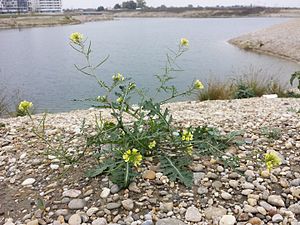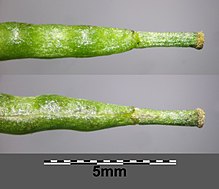French dog mustache
| French dog mustache | ||||||||||||
|---|---|---|---|---|---|---|---|---|---|---|---|---|

French dog mustache ( Erucastrum gallicum ) |
||||||||||||
| Systematics | ||||||||||||
|
||||||||||||
| Scientific name | ||||||||||||
| Erucastrum gallicum | ||||||||||||
| ( Willd .) OESchulz |
The French dog mustache ( Erucastrum gallicum ) belongs to the genus of the dog mustache .
description
The French dog mustache is a one to two year old 10–60 cm high plant. The upright, branched stem is hairy at the base. The leaves are pinnate to pinnate, with 4–8 sections on each side. The lower flowers are in the axils of bracts. The sepals are 4–5 mm long, somewhat hairy and are almost upright. The petals are 7–9 mm long, pale yellow-whitish, more rarely golden yellow.
Flowering time is from May to October.
The pods are 25–50 mm long, they stand on 5–15 mm long stalks. The fruit beak is 2–4 mm long, clearly separated from the rest of the fruit and it bears no seeds. The seeds are oblong-egg-shaped, 1–1.3 mm long and 0.6–0.8 mm wide.
The number of chromosomes is 2n = 30.
ingredients
The seeds of the French dog mustard contain gluconapine and sinigrin , from which butyl mustard oil and allyl mustard oil are split off.
General distribution
The French dog mustache is predominantly subatlantic, is widespread in southern and central Europe and is a neophyte in the rest of Europe, North America and the Bahamas .
Locations
The French dog mustache needs base-rich, but only moderately nitrogen-containing, slightly moist, loose clay soil interspersed with sand.
It colonizes fallow land and root crop fields, but it also goes into gutted wasteland, and it occasionally grows on railway gravel and along roadsides. It is a character species of the Mercurialetum annuae from the Fumario-Euphorbion association, but also occurs in societies of the Sisymbrion verb.
In Central Europe it occurs sporadically in the lowlands, as well as in the Swiss Jura and in the Alps; from the Middle Rhine to the High Rhine, on the Neckar and Danube (to the east of Vienna) as well as in the foothills of the Alps, it is rarely found, and there it occurs mostly only inconsistently.
literature
- Otto Schmeil, Jost Fitschen (greeting), Siegmund Seybold: The flora of Germany and the neighboring countries. A book for identifying all wild and frequently cultivated vascular plants . 95th completely revised u. exp. Edition. Quelle & Meyer, Wiebelsheim 2011, ISBN 978-3-494-01498-2 .
- Oskar Sebald, Siegmund Seybold, Georg Philippi (Hrsg.): The fern and flowering plants of Baden-Württemberg . Volume 2: Special part (Spermatophyta, subclass Dilleniidae): Hypericaceae to Primulaceae. 2nd expanded edition. Eugen Ulmer, Stuttgart 1993, ISBN 3-8001-3323-7
- Henning Haeupler , Thomas Muer: picture atlas of the fern and flowering plants of Germany (= the fern and flowering plants of Germany. Volume 2). 2nd, corrected and enlarged edition. Published by the Federal Agency for Nature Conservation. Ulmer, Stuttgart 2007, ISBN 978-3-8001-4990-2 .
- Dietmar Aichele, Heinz-Werner Schwegler: The flowering plants of Central Europe , Franckh-Kosmos-Verlag, 2nd revised edition 1994, Volume 3, ISBN 3 440-08048-X
Individual evidence
- ↑ a b Erich Oberdorfer : Plant-sociological excursion flora for Germany and neighboring areas . 8th edition. Verlag Eugen Ulmer, Stuttgart 2001, ISBN 3-8001-3131-5 . Page 438.
- ↑ Erucastrum in the Germplasm Resources Information Network (GRIN), USDA , ARS , National Genetic Resources Program. National Germplasm Resources Laboratory, Beltsville, Maryland. Retrieved July 18, 2017.
Web links
- French dog mustache. In: FloraWeb.de.
- Distribution map for Germany. In: Floraweb .
- Erucastrum gallicum (Willd.) OE Schulz In: Info Flora , the national data and information center for Swiss flora . Retrieved October 24, 2015.
- Distribution in the northern hemisphere according to: Eric Hultén , Magnus Fries: Atlas of North European vascular plants 1986, ISBN 3-87429-263-0
- Thomas Meyer: Data sheet with identification key and photos at Flora-de: Flora von Deutschland (old name of the website: Flowers in Swabia )




